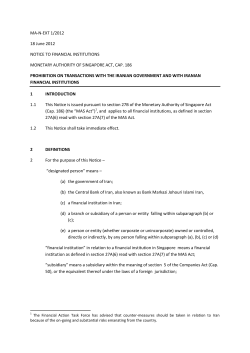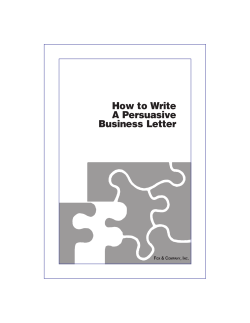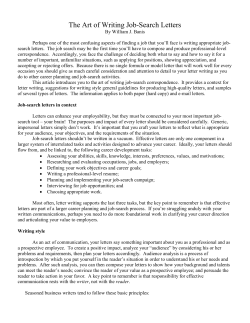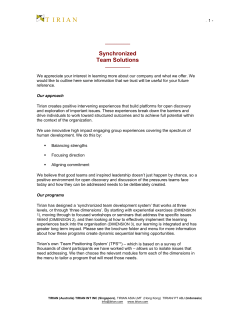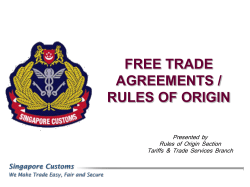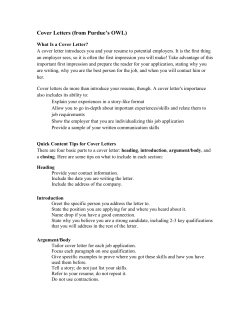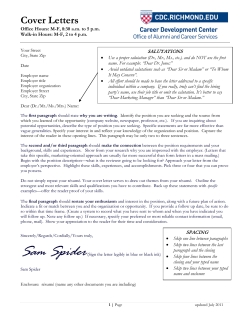
BUSINESS LETTER WRITING: DRAFTING AND REVISING
BUSINESS LETTER WRITING: DRAFTING AND REVISING Week 6 LEARNING OBJECTIVES: To learn about coherence as an important element in the drafting process To learn about tone and style through specific language uses To appreciate the role of tone, culture and persuasion in drafting business letters To be familiar with the general framework of questions for revising letters In drafting your letter, there are three important things that you need to consider. These are: o Be coherent o Use appropriate language (3Cs) o Establish good reader‐writer relationship (4Ps) OHERENCE C The earlier set of notes should have given you a clear idea of the role of organization in business letter writing. Specifically, the earlier notes should have provided you with an overview of the many possible ways of organizing your business letter according to the needs of your target readers. However, while you now may have a clear idea of how to deliver your main message in an organized way, the drafting stage still requires you to work on your organization in more specific ways. That is, you must now use language strategically to put your ideas together in order to achieve a coherent letter. In other words, how you want to organize the content of your letter must be surfaced explicitly through your use of language. Use linking words Linking words show the connection between what has been said and what comes next. This helps the reader to understand a message more easily because they act as signposts to the reader, allowing her to predict what is coming. They help avoid abruptness and allow the writing to flow more smoothly. 19 | P a g e ©Centre for English Language Communication National University of Singapore Linking words may be used: Linking words may be used: within a sentence Managers were generally reluctant to employ part‐time staff; however, this was not always the case. Note how ‘however’ helps to make the above sentence coherent by linking the two parts together in a contrast relation. within a paragraph The company has not made a cent of profit over the last twelve months. We are no longer attracting investors like we used to. There is evidence of growing absenteeism among both office staff and workers. Therefore, the Board of Directors feels that certain drastic measures have to be taken. Note how ‘therefore’ signposts a conclusion to the paragraph, helping it to cohere together as a single unit. between two paragraphs VideoSing, Ltd recognizes your contributions to the success of the global premier of A1GX™ Videos in Singapore. Such efforts cannot go unrewarded. In this connection, we would like to invite you to our Testimonial Dinner 2010 in honour of our most valuable employees like you to be held on Friday, 24 September 2010, at 8 o’clock in evening. The venue will be at the Grand Ballroom of Epic Venus Hotel on Orchard Link. Note how ‘In this connection’ links the second paragraph to the first paragraph, by connecting the two in a kind of cause‐effect – or ‘what then?’ – relationship. Pronouns may also be used to connect ideas smoothly since they refer to words previously mentioned. For example, instead of: “Below is a list of retail outlets. The retail outlets are divided into three types....” it is better to say: “Below is a list of retail outlets. They are divided into three types.” However, care should be taken to ensure that any pronouns used should not be ambiguous. For example: 20 | P a g e ©Centre for English Language Communication National University of Singapore “ Our bank is pleased to announce a new partnership with the Development Bank of Boracay for a regional initiative to combat climate change. Its main inspiration is...” (Its is ambiguous here. Does it refer to the bank, the new partnership or the regional initiative?) Use parallel structure In business letter writing, we often need to make lists of items (e.g., instructions, conditions, sets of advantages or disadvantages, recommendations). These items appear more coherent to the reader if they are expressed in similar grammatical patterns, i.e., in parallel structure. Look at the following example: Model 201A has the following advantages Model 201A has the following advantages over Model 301A: over Model 301A: a) b) c) d) Small and relatively portable Simplicity Ruggedness No requirements for highly trained operators e) Economy of operation a) b) c) d) Small and relatively portable Simple Rugged Easy and cheap to operate (combining d and e) Note how the advantages listed on the left are not in parallel structure. Different grammatical structures ‐ abstract nouns, noun phrases, adjectives ‐ are used, making it difficult for the reader to process the information. In the improved version on the right, the construction has changed so that the advantages are in parallel form (all adjectives), making the information more coherent and accessible. Give the right amount of emphasis The right amount of emphasis or focus improves the coherence of the message and makes it easier to understand. Business writers use four major ways to emphasise important ideas: o using short sentences Short sentences carry more emphasis than longer ones, which tend to de‐emphasise contents. For example: 21 | P a g e ©Centre for English Language Communication National University of Singapore A sample long sentence which de‐emphasizes content At this point it cannot be emphasised strongly enough that a high and consistent work‐rate maintained by each and every member of the work force is crucial for the economic well‐being of the company. A sample short sentence which emphasizes content Maintaining a high work‐rate is crucial. o subordinating less important ideas In complex sentences, the idea expressed in the independent or main clause is naturally emphasized, while that in the dependent clause(s) is naturally de‐emphasised. Therefore, primary information should be placed in the independent clause, and secondary information in the dependent clause. Sentence A Jean took a job in insurance, although she really preferred a job in accounting. Sentence B Although she took a job in insurance, Jean really preferred a job in accounting. In Sentence A, the emphasis is on Jean’s taking a job in In Sentence B, the independent clause is “Jean really insurance; the independent clause is “Jean took a job in preferred a job in accounting”; the sentence insurance”. construction has been switched around to emphasize her preference for a job in accounting. o numbering and tabulating ideas This is commonly used in business writing to create emphasis. For example: The problems have been narrowed into three categories: (1) absenteeism (2) lateness (3) alcoholism Here, the three categories are visually clear and easily enumerated. o using bold type, italics, underlining, and headings and sub‐headings These are ALL things we do physically to emphasize the written or printed word. 22 | P a g e ©Centre for English Language Communication National University of Singapore Maintain unity in sentences and paragraphs For sentences, unity means that everything in a sentence should form one complete thought or idea. Do not put unrelated ideas in a sentence: Mr Chen is our sales manager, and he has a degree in law. Better to put unrelated ideas in separate sentence: Mr Chen is our sales manager. He has a law degree. Or subordinate one idea to the other: Mr Chen, our sales manager, has a law degree. For paragraphs, unity means that every sentence in a paragraph should centre around one topic or central idea. The example below shows a paragraph which does not have unity. By shifting to personal qualities, the third sentence violates paragraph unity. Omitting this sentence would correct the error. At the University, I studied all the basic accounting subjects as well as specialised courses in operations research, banking, and information systems. I also took modules in the behavioural areas, with emphasis on human relations. Realizing the value of human relations in business, I was active in extra‐curricular activities, such as the Marketing Club, the Cultural Activities and Community Service Club, and the Toastmasters Club. I selected my elective coursework to round out my general business education. Among my electives were modules in investments, business communications, and culture and society. A look at my resume will show you the additional modules which round out my university education. TYLE AND TONE To achieve appropriate tone in your business letter, you must style your writing. Style and tone are two sides of the same coin. Style is made up of the words and sentences that a writer chooses in order to produce a desired response in the readers. Tone refers to the unwritten or unspoken message that comes across in your communications. It is sometimes referred to as the message “between the lines” which, of course, depends on your word choice and your expression of ideas. S 23 | P a g e ©Centre for English Language Communication National University of Singapore SENTENCES STYLE (expressed message) TONE (hidden message) I sold 25 pieces of the product. Begins with personal pronoun “I’ Informal, personal “I” is the actor (or doer) in the sentence Active construction is used 25 pieces of the product have been sold. No “I”; no ‘doer’ of the action Please be informed that… Begins with ‘Please’ Formal, impersonal Passive construction is used Polite, potentially formal Uses the passive form ‘be informed’ I would like to inform you that… Begins with the ‘I’ pronoun You should know that… Begins with the ‘You’ pronoun and continues with an imperative ‘should’ Polite, personal Uses the active form ‘I…inform you’ Informal, demanding, angry Style and tone have a profound influence on the effect the message will have on your reader. However, while you can indeed style your sentences in a way that achieves a particular tone, be mindful of the fact that it is the combined styling of structure, sentences and words in your letter (bearing in mind too that role of reader in your decision on how to write the letter) that determines the general tone of the letter. One phrase above – ‘Please be informed that…’ may be a style that can achieve a polite and formal tone, but it is still not a guarantee that everything else in the letter is also polite and formal. Consistency is very important in this regard. In fact, as soon as you complete the phrase, your tone may have changed completely, as in: Please be informed that you will not be refunded for the exorbitant expenses incurred during the staff retreat. In business letter writing, thus, apart from choosing the appropriate content and adopting a suitable organizational framework, it is also important to pay attention to how you express your ideas in writing. In the following sections, you will be introduced further to more specific elements of style and tone in business letter writing. These are the 3C’s of language and the 4P’s of a positive reader‐writer relationship. 24 | P a g e ©Centre for English Language Communication National University of Singapore T HE 3Cs Three words best sum up what good business language should be: Clear, Concise and Correct. Your writing, in other words, must be simple and understandable. Essentially, the language of business to be described below is important in all forms of business communication. CLEAR Prefer short, simple words Short, familiar words communicate more clearly than longer, less used words. Long words may look impressive, but they may not be understood and they may distract the reader from the message. Instead of: terminate remunerate endeavour cogitate procure scrutinize, probe stipulate necessitate This machine has a tendency to develop excessive and unpleasant audial symptoms when operating at elevated temperatures Use or write: end pay try think buy study, inspect specify require This machine tends to get noisy when it runs hot. However, the above examples, and all other possible examples, must be used with caution. While the objective is to use simple and shorter words, you do not do so at the expense of other considerations, such as the use of concrete and specific words. For example, the word ‘ask’ may be shorter than ‘enquire’ or ‘demand’, but these last two words have shades of meaning which are concrete and specific. To ask for an explanation is different from to demand an explanation. The key point to make basically is that if your meaning can be expressed more clearly by a shorter or more simple word, then use this word. Do not use longer words just because you want to impress your reader. 25 | P a g e ©Centre for English Language Communication National University of Singapore Use concrete, specific words If possible, use concrete words because they stand for specific things that people can see, feel, taste, hear or smell. Abstract words should be avoided as much as possible because they tend to have broad, general meanings. Thus, present specific facts, details, and examples. Abstract Concrete A significant loss A 53‐percent loss Good attendance record 95‐percent attendance record The majority 65% At the soonest possible time By 5 p.m., Friday Substantial amount $ 2.7 million A relatively new product A new product introduced in 2008 Keep sentences short Shorter sentences and paragraphs are easier to understand and likely to contain fewer errors. Unnecessary words that add nothing to the meaning and the impact of the sentence or paragraph should be omitted. Most business communication experts recommend writing with an average sentence length of between 20 and 25 words. Sentences over 40 to 50 words long should be re‐considered to decide whether they should be re‐written. Of course, sometimes longer sentences can, and should, be written. This is necessary in order to complete a thought or idea, to provide variety in sentence length, and to subordinate less important information. But in writing long sentences, care should be taken to ensure that they are clear and the important point is not lost. CONCISE Being concise means using the fewest possible words to get a message across to the reader. Longwinded writing can be annoying because unnecessary words, irrelevant details and muddled expressions waste the reader’s time. However, concise writing does not mean sacrificing clarity or essential information. Conciseness is still about using the fewest possible words to get the same message across in the clearest possible way. 26 | P a g e ©Centre for English Language Communication National University of Singapore Avoid redundancy Do not use two words with the same meaning in the same sentence. In the following examples, the word in italics is redundant and should be left out: my personal opinion after three hours later prompt and speedy attached hereto Avoid wordy expressions Note how the expressions below can be shortened without losing any meaning: From at the present time in the near future in very few cases I am of the opinion that Prefer strong verbs and the active voice To now soon seldom I think Strong verbs are those which describe actions directly. By contrast, weak verb forms are those which have action words as well as nouns. Hence, weak verb forms use more words to describe the same action as its equivalent strong verb. Weak verb forms should be avoided also because they tend to be abstract and usually require the passive voice. Weak verb make an acquisition give assistance to have a discussion conduct an investigation We must aim for a reconciliation of our differences The establishment of a rehabilitation centre has been accomplished. Strong verb acquire assist discuss investigate We must reconcile our differences. The company has established a rehabilitation center. 27 | P a g e ©Centre for English Language Communication National University of Singapore CORRECT Grammatical correctness is vital in business writing. A letter or report going outside the company and bearing the company's letterhead gives a poor impression of the company if it contains obvious errors. Use correct tenses Note, for example, the shift from past tense to present tense in the sentence below: Many of our customers thought that UltraCab is the most reliable taxi company. However, they also believe that taxis have become a very expensive mode of transportation. (There is no clear reason why the tenses are different for the underlined words) Make sure there is subject‐verb agreement Make sure that the subject and the verb in sentences are in agreement. Singular verbs should be used when the subject is in the singular. Note how this is not the case with the following: Feedback are reviewed and acted on..., The Singapore worker, partly through legislation and partly through his own attitude, have lost progressively fewer working days. Use articles correctly (i.e., "a" and "the") The usage of articles poses particular problems to many people. Take note of the following guidelines. o General reference When something is referred to as a whole class of things or in a general sense (general reference), a plural noun and no article is used. Job interviews are nerve‐wracking occasions. It is also possible to use "the" with a singular countable noun to make a general reference The job interview is a nerve‐wracking occasion. 28 | P a g e ©Centre for English Language Communication National University of Singapore o Specific reference The article "a" or "an" is used when referring to something that has not been mentioned before or that the reader does not know about. I had an interview for a job with an insurance company yesterday. The definite article "the" is used when referring to something that has become old information or known to the reader: I had an interview for a job with an insurance company yesterday. The interview went well and I liked the company, but I don't think I'll get the job! T HE 4P’s To establish a positive reader‐writer relationship, you must do the 4P’s: Be Polite Be Positive Be Personal Be Professional Be polite No matter how aggravating the circumstances, always write courteously as this style of writing fosters a positive relationship with your reader and is more likely to bring about a favorable response. To come across as polite in your writing, you need to write in a style that: reflects an appropriate reader‐writer relationship, does not convey a sense of superiority/anger/condescension, or does not embarrass the reader. The table below gives some examples. Writing that Examples Tone Reflects an appropriate reader‐writer relationship (a) With effect from 14 July, your goods must be delivered at 7.00 am sharp. I seek your cooperation in this respect. Not polite (b) My suggestion is that we deliver your goods promptly at 7.00 am instead of the usual 6.30 am. I hope this arrangement is convenient for you. Polite 29 | P a g e ©Centre for English Language Communication National University of Singapore Does not convey a sense of superiority, anger or condescension (a) If you had read Section IV of your policy, you would know Angry that you are not covered for accidents which happen on water. (b) As a review of Section IV of your policy indicates, you are Composed covered for accidents which happen on the grounds of your home only. Does not (a) As you did not respond within 10 days, it should be clear embarrass the to you that you did not qualify for the free gift. reader (b) You probably did not notice that your order was mailed after our special gift offer had expired. Accusative Rude Polite, Conciliatory Avoids preaching (a) We deeply understand your situation and we will do our Preachy best to help you pay your remaining dues. We do believe though that a financial adviser can help you avoid similar problems in the future. (b) We deeply understand your situation and we will do our Genuine best to help you pay your remaining dues. Be positive Being positive in your writing also helps to generate a more favorable response to your message, so: o use positive words and phrases, and o stress what can be done. The table below gives some examples. 30 | P a g e ©Centre for English Language Communication National University of Singapore Writing that: Examples Style/Tone Uses positive (a) There are no more places for the May 15 seminar and words/phrases there will be no similar seminar organized until October. (b) Due to its popularity, all places for the May 15 seminar have been filled. A similar seminar will be organized in October and we will be happy to reserve a place for you, if you like. Stresses what can be done (a) The problem will be resolved if you connect the wires according to the instructions given. (b) The problem would not have happened if you had connected the wires properly. Negative Positive Be personal The style and tone of your letter will also be improved if you could be more personal in your writing. The ways to achieve this include: adopting a “you” attitude, using personal pronouns, and avoiding pompous words/phrases. The “you” attitude in business letter writing is a style of writing that looks at things from the reader’s perspective and expresses genuine consideration for the reader. To project this attitude in your writing, you need to recognize and understand the reader’s situation and you should be interested in helping in a sincere and courteous way. When writing with the “you” attitude, you need to emphasize what the reader wants to know, respect the reader’s intelligence and protect the reader’s ego. The table below gives some examples that demonstrate ways in making your writing more personal. Writing that: Examples Style/Tone Adopts a 1(a) We are happy to announce that we have increased Straightforward, Informative “you” attitude the size of our store building. (b) Now you will find a wider choice of merchandise in Personal, the greatly enlarged building. Engaging 31 | P a g e ©Centre for English Language Communication National University of Singapore Uses personal pronouns (a) If there should be any questions concerning this matter, please call the number listed on the letterhead above. Formal Detached Personal Friendly (b) We look forward to working with you. Meantime, if there is anything further that we can do for you, please let us know. Avoids (a) I want to cogitate further on the matter before giving a definitive answer. pompous words/phrases (b) I want to think about the matter a little more before I give a final answer. Pompous Unpretentious Be professional Finally, you can also improve the style and tone of your messages by being professional in your writing. This requires you to look at situations in an objective and professional manner. To do this, you must try to: Generalize experiences and simplify examples Be objective Maintain dignity Be sincere The following table gives some examples. Writing that: Generalizes experiences, simplifies examples Is objective Examples (a) For example, I once waited 40 minutes for a service 197 bus because two previous buses passed without stopping. (b) There was one time when I spent nearly 40 minutes waiting for two buses on Service 197 which drove past without stopping. Then there was another time when… Style/Tone Concise Simple Too detailed (a) Moreover, the bus drivers of such oncoming buses would Subjective seize the opportunity to steer right and bypass the bus stop. Emotional 32 | P a g e ©Centre for English Language Communication National University of Singapore Maintains dignity Is sincere (b) Furthermore, the bus drivers who tailgate other buses also tend to bypass the bus stop. Objective (a) As a valued customer, you can rest assured that we will take every precaution to ensure that you get the best service in the future. Dignified Undignified (b) Since you are our valuable customer, we hope you will give us another chance to prove that we can do a good job. (a) Your phenomenal contribution to our understanding of tax laws is remarkable. (b) We would like to thank you for helping us gain a better understanding of tax laws. Exaggerated Sincere Truthful 33 | P a g e ©Centre for English Language Communication National University of Singapore TUTORIAL EXERCISES ACTIVITY 1 BRANDING SINGAPORE Singapore has recently embarked on a project to change its image to people outside the country. This is spearheaded by the Ministry of Information, Communications and the Arts (MICA). The new formula focuses on branding Singapore as “nurturing”, “transforming”, actively “collaborating” and “daring to dream”. The plan, however, will not replace the core values which Singapore has been known to represent such as “safe”, “clean” and “efficient” (see Tan, 2010, p. E2). The following are some examples of words to be avoided (off‐brand) and alternative words (on‐brand) as they appear from the Brand Singapore Messaging Guide (see Tan, 2010, p. E3). Off‐brand On‐brand x Authorize √ Enable, empower x Convert √ Adapt x Insist √ Request x Rules and regulations √ Guidelines x Revolutionary √ Innovative, new QUESTIONS 1. What transformations in meaning occur if off‐brand words are changed to on‐brand ones? Study each of the words above. 2. By branding Singapore through practices such as linguistic changes above, what do you think come first – words changing reality or reality changing words? 3. Is Branding Singapore a form of business communication? ACTIVITY 2: Changing tone through linguistic transformations The following memo is written by Chng Meng Teng, Assistant Manager (in charge of Delivery and Related Services or DRS) of Machines and Technical In‐sourcing, Inc. This memo is addressed to all 24 staff members belonging to the DRS Department of the company, many of whom are senior members who have served the company for more than 20 years. Mr Chng, who has an MBA degree from a European institution, was recruited by the company three years ago to help improve its sales and public relations. The work entailed in the memo may prove 34 | P a g e ©Centre for English Language Communication National University of Singapore difficult to most people because it came at a time when the mid‐year sales individual review puts a lot of stress on everyone. Critically review the email that Chng Meng Teng has written and answer the questions that follow. MEMORANDUM To : All staff, DRS Department From : Chng Meng Teng Date : 15 July 2010 Subject : Updating database As I already mentioned to you in our meeting two days ago, I want you now to be responsible for updating into our database information on all delivered machines. Such responsibilities include the following: 1. Updating every two working days all the names of customers and the equipment they bought. 2. Updating the database with all the missing S/N, receipt numbers, options, end customers, POs, installation dates, delivery dates, contact persons, etc. By the end of next week, all delivered machines shall be found and detectable in our database. The database may look rather complex but since you’ve worked with computers, you should have no problem figuring out how it works. 3. Following up on installation reports. If the equipment is already delivered but installation reports are not yet available in Singapore, Johor and Penang, hound the agent or rep office to send you the report. I don’t accept any excuse from the agent. And you are not to accept any excuse from the agent as well. This issue has become important now and therefore I require you to take responsibility for this. I demand 100% compliance. CMT In general, how do you describe the tone of the memo? Choose at least two words that appropriately describe the tone (e.g., friendly, respectful, angry, condescending) and specifically identify words, phrases or sentences in the memo which serve as evidence for your observation. Below is a revised version of the memo. Read it and follow the instructions below: 35 | P a g e ©Centre for English Language Communication National University of Singapore MEMORANDUM To : All staff, DRS Department From : Chng Meng Teng Date : 15 July 20xx Subject : Updating database As a follow‐up to my directive in our meeting two days ago, I urge you to be responsible for updating our database with information on all delivered machines. The following are your responsibilities: 1. Update the database every two working days with all the names of customers and the equipment they bought. 2. Update the database with all the missing S/N, receipt numbers, options, end customers, POs, installation dates, delivery dates, contact persons, etc. By the end of next week, all delivered machines should have been entered in the database. The database may look rather complex but it is actually easy to use. Should you need help to use it, do not hesitate to contact Ronnie Chua or Maybelle Ng from the IT Division. 3. Follow up on installation reports. If the equipment is already delivered but installation reports are not yet available in Singapore, Johor and Penang, chase the agent or rep office to send you the report. We should not accept any excuses from the agent. This has become an important issue now because of the need to become more transparent and more efficient in our delivery of services and accounting of facilities and finances. Therefore, everyone must be responsible for updating our database with the necessary information. 100% compliance is required. CMT Instructions: Describe the general change in tone (or ‘voice’) in the memo. Identify or underline the changes made that led to this shift in tone. Describe the stylistic or linguistic strategies employed in each change. 36 | P a g e ©Centre for English Language Communication National University of Singapore ACTIVITY 3: Changing attitudes through changes in style Read the original sentences below and find out how each has been revised to achieve a different tone1. What attitudes are conveyed by the original sentences? What could be the effect of the revision on the reader? Original Revised 1. As you would certainly agree, I am qualified for the position I am applying for. 2. You left the front door open last Friday, thus security of personnel was compromised. 3. Each employee is encouraged to bring his family to the company dinner. 4. Our company is working on your order now. 5. I am sorry to inform you that I am turning down your invitation to speak on “Global trends in finance management” in your seminar this November. It does not give me an opportunity to utilize my expertise in cross‐ cultural communication. 6. We are very sorry that we cannot give you the discount you requested. 7. We regret to inform you that we are unable to give you the discount you requested. Our company has recently been affected very badly by the global slump in electronic sales. 8. Since you have not emailed us your preferred mode of payment within the specified deadline, we are forced to deduct the amount due from your checking account at the soonest possible time. 9. We would appreciate it if you advise us on what you want to do with your order. You may wish to have it sent via air cargo (S$58) or shipment (S$14). 10. The company is in receipt of your correspondence regarding advanced hotel bookings for the conference. 1. I am confident that my extensive experience in the retail industry meets your requirements for the jobs. 2. Security of personnel was compromised because the front door was not closed last Friday. 3. Employees are encouraged to bring their families to the company dinner. 4. Your order will be shipped to you in four days. 5. I am sorry to inform you that I am unable to accept your invitation to speak on “Global trends in finance management” in your seminar this November. My expertise is in cross‐cultural communication, not finance management. 6. We regret to inform you that we are unable to give you the discount you requested. 7. Due to the recent global slump in sales, we regret to inform you that we are unable to give you the discount you requested. 8. Since the deadline has lapsed for customers to email us their preferred mode of payment, we will deduct the amount due from your checking account on Monday, 3 October 2008. 9. Please let us know if you want your order to be sent via air cargo or shipment. Air cargo costs S$58 while shipment (3‐4 weeks) costs S$14. 10. We received your request for advanced bookings for the conference. 1 Note that the revised sentences are not necessarily ideal sentences that can be used in any business communication context. The purpose of this activity is for you to see how style has been changed to produce a different tone. You may learn from some of the strategies used in rewriting the sentences. 37 | P a g e ©Centre for English Language Communication National University of Singapore ACTIVITY 4: Establishing reader‐writer relationships through language use Read the following two letters which represent different responses to an unsolicited job application. LETTER 1 I appreciate your interest in a position with Research Communications. Thank you for sending us your letter and resume. Your qualifications are very good and I wish that we were able to make use of your obvious talents. However, our Marketing Department has no open positions at the present time. I will be happy to keep your letter and resume just in case a job opening becomes available in Marketing. If so, you may be sure that I will contact you. In the meantime, I suggest that you continue your job search with other companies, and might I wish you luck in your search. Thank you once again for your interest in Research Communications. LETTER 2 Your application for a position with Research Communications has been received. Thank you. Unfortunately, there are no vacancies in our Marketing Department at this time. Further, we expect no vacancies in this department in the near future. We therefore regret to inform you that we cannot process your application because of lack of vacancy in the department. Your interest in Research Communications is appreciated. Should you need further clarification, please do not hesitate to contact me. We will answer your questions as best as we can, but we are deeply sorry for not being able to consider you for any vacancy in our department. Our best wishes in your career. Now answer the following questions. 1. Which of the two letters establishes a more positive reader‐writer relationship? 2. Identify the elements of style and tone that make the letter more effective than the other. Bibliography Tan, H. (2010, July 10). Jumping on the brandwagon. The Straits Times , pp. E2, E3. 38 | P a g e ©Centre for English Language Communication National University of Singapore
© Copyright 2025
